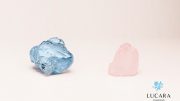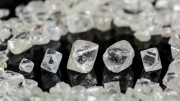“I don’t ever believe in using the word try,” says William Lamb, the current driving force behind Lucara Diamond (LUC-T). “If you try, you are setting yourself up for failure. You are either going to do something or you are not, so when you say you are going to do something, you continue to work at it until you achieve,” the 41-year-old mining executive said in a telephone interview from Johannesburg in late September.
Lamb’s philosophy of achievement comes from the realm of sports training.
While the Vancouver-based president and CEO of Lucara is a seasoned runner, he recalls his first duathlon, near his hometown of Johannesburg, as something of a challenge.
The short race consisted of a 4-km run, 20 km of cycling, and another 4-km run.
“I had to get off the bike twice and walk,” Lamb confesses. “I was terrible.”
But after six years of continuous training, he qualified for the South African duathlon team and began racing competitively, even completing several triathlons.
Lamb says he takes a similarly determined approach to conducting business at Lucara, a new junior diamond producer with operations in southern Africa.
“The planning process is the same as training,” he asserts. “You have to put the steps in place so you can actually achieve your goals.”
Lamb was appointed president and chief operating officer at Lucara in July 2009, becoming CEO in April 2010.
And this year, Lamb oversaw the commissioning and ramp up of the company’s first mine, its 100%-owned Karowe mine (previously the AK6 project), in Botswana.
Lucara also holds 75% of the Mothae diamond project in Lesotho, with the country’s government holding 25%. Both assets contain high-quality type IIa diamonds.
Karowe, which translates to “precious stone” in the local dialect, started commercial production on July 1, 2012, and is on its way to meet this year’s production guidance of 270,000 carats.
The open-pit operation has a 15-year mine life based on probable reserves of 36 million tonnes containing 6.3 million carats. It also holds indicated resources of 51 million tonnes grading 22 carats per hundred tonnes for 11 million carats, with another 4 million carats in inferred resources.
But the ride to this point has had its bumps. In August, Lucara trimmed Karowe’s 2012 sales forecast to 230,000 carats from 300,000 carats and increased its cash cost guidance to US$22.50 per tonne from US$20, after a water shortage at the plant forced it to install additional water wells to process the weathered ore. This, along with lower-grade stockpiles that were fed to the mill in August and September contributed to the reduced sales projection.
Currently, the plant, which is designed to process 2.5 million tonnes a year, is running “exceptionally well,” Lamb says. At this rate, Karowe is set to produce 400,000 carats in 2013, its first full year of production.
After disappointing average sales prices from Karowe’s first two diamond sales in June and July, Lucara reported a much improved price of US$257 per carat in its September auction.
The first two sales fetched US$215 and US$179 per carat, well below the US$301 per carat Lucara reported in an independent valuation last December.
However, Lucara had withheld some high-quality stones in the first two tenders, where it had viewings only in Gaborone. And those viewings attracted fewer clients than the company’s September sale, when it held showings in both Gaborone and Antwerp.
In a research note, Ed Sterck, a U.K.-based mining analyst with BMO Capital Markets, wrote that while the September average of US$257 per carat is 15% below the US$301 per carat valuation, that’s “broadly in line with changes in diamond prices year to date.”
The three auctions generated roughly US$25 million in revenue and the miner plans to hold two more sales this year, with showings in Gaborone and Antwerp.
Meanwhile, at Mothae, Lucara completed its third and final diamond sale in September, marking the end of a trial mining program. The sale brought in $1.5 million for an average price of US$324 per carat.
Lucara aims to finish an ongoing preliminary economic assessment at Mothae, along with an NI 43-101 technical report, in the first quarter of 2013. If the study is positive and there’s enough grid power available to get Mothae up and running, the junior may have a second mine onstream by the end of 2015.
‘Something to do with mining’
Growing up in South Africa, Lamb was exposed to mining at a young age. His father worked in an administrative role at Rand Mines’ coal head office, and Lamb visited several gold mines in and around Johannesburg on school trips.
These experiences helped him appreciate the importance of mining, he says. “If you look at the expandability of the economy, anywhere you go regardless of what you look at, it is always going to have an aspect of mining,” Lamb explains. “If you go back to the base roots, everything has something to do with mining.”
After earning a degree in extraction metallurgy from what is now the University of Johannesburg, Lamb worked at Rand Mines, gaining expertise in gold, platinum, chrome and coal.
In 1994, Lamb joined De Beers as a research officer, leaving after three years for a more challenging position as Kvaerner Metals’ lead process design engineer.
Shortly thereafter, however, De Beers lured him back with the offer of a more demanding position as a dense medium separation service specialist.
Lamb spent eight years in total with De Beers in South Africa, before transferring in 2002 to the company’s Canadian operations as a project metallurgical superintendent, also serving a stint as a process manager at the Victor mine in Ontario.
He credits De Beers director John Hughes as a mentor who helped him understand the strategies behind running organizations.
“Any large corporation will be very happy to help you focus on the technical aspects, but very seldom do they allow you to understand the business side of things,” Lamb says.
Lamb went on to complete a distance-learning MBA program from the Edinburgh Business School in 2007, and a year later, joined the Lundin Group as general manager at Lucara Diamond. From there, he ascended the corporate ladder to his current position, which has him on-call at all hours.
“I get called at two o’clock in the morning because when I’m in southern Africa and people want to speak to me from Vancouver, they just pick up the phone and call,” he says. “I think the responsibility of operating and managing a diamond mine, especially when you are across so many time zones, is you need to be available 24-7.”
That means frequent travel to Lucara’s projects and when he’s in Vancouver, working days, evenings and early mornings in order to stay in touch with operations staff both at the start of their day and the end.
Lamb notes that Lucara has come a long way in just a few years.
“We started off with a company that had really nothing. We had an option to earn into the Mothae project,” Lamb says.
Previously a precious metals explorer known as Bannockburn Resources, the company started scouring Africa for diamond prospects in 2006. A year later, it secured an option agreement for 70% of Mothae with the aid of Eira Thomas and Catherine McLeod-Seltzer.
The two accomplished women, along with mining entrepreneur Lukas Lundin, provided seed capital for the junior, which was renamed Lucara (borrowing two letters each from Lukas, Catherine and Eira) in 2007.
Lucara eventually acquired Motapa outright to gain control of Mothae. It then purchased De Beers’ 70% stake in Karowe before taking over its joint-venture partner there.
The company’s acquisitive past may hold clues to its future. Lamb says in the long term, he aims to position the well-financed and technically savvy company for growth.
“We would like people to see us as a potential partner to assist them with the development of their operations and through that, we could see some consolidation in the sector.”
But for now, the junior will focus on sustaining operations at Karowe and advancing Mothae.
“At the moment, we need to demonstrate to the market that we’ve got sustainability at our operations, and what we said we were going to do, we’ve done.”
Lucara shares recently traded at 62¢ in a 52-week window of 49¢-$1.20. The company has 376.3 million shares outstanding.
— The author is a staff writer with The Northern Miner.





Be the first to comment on "Lucara Diamond CEO just getting started"